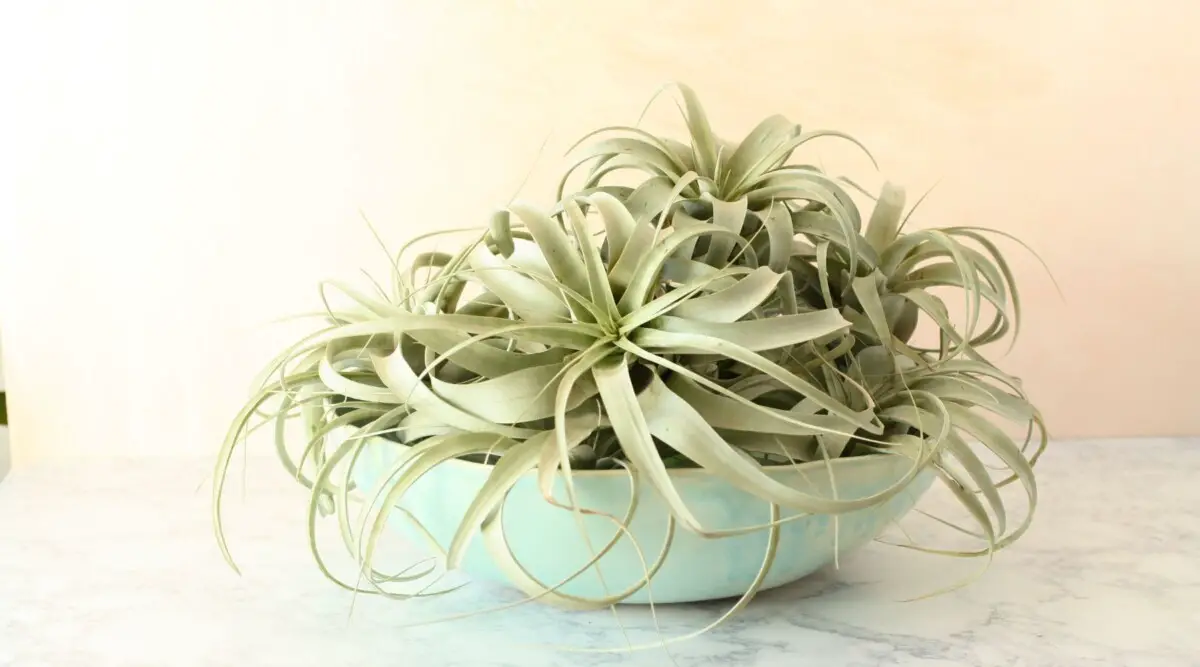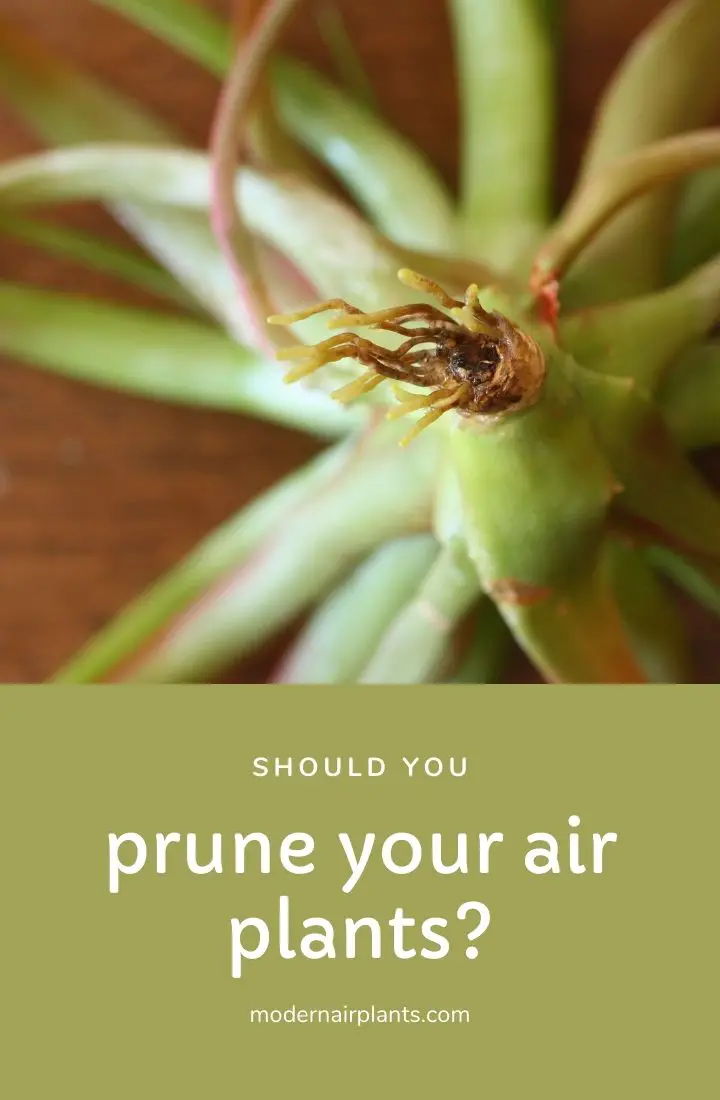
Should Air Plants Be Trimmed? What You Need To Know
Like any other plant, air plants need maintaining and grooming every once in a while. Trimming isn’t limited to sick air plants—even the healthy ones need pruning.
This post may contain affiliate links, and I love all the products I promote.
Air plants should be trimmed, especially the dead and brown leaves so new ones can grow. You should cut the dried leaf tips, broken or sick leaves, and dead flowers. Cutting off the roots is optional and won’t hurt the plant. It’s also up to you to detach the air plant’s pups once they’re grown.
This article will help you realize when and how to prune your air plants. If you’re not prepared, you might over-trim, ultimately hurting your plant.

Air Plant Roots
Air plant roots fulfill a different purpose than other plant varieties. They can’t absorb water or nutrients; instead, they anchor the plant to other plants, trees, and rocks in nature.
Once you buy an air plant, you can let it anchor itself to a piece of driftwood or wreath, but it’ll take some time. It’s also possible to glue the roots down to where you want to fasten the air plant.
If the roots are missing when you buy the plant, don’t worry! They grow back in no time.
However, some people find that air plants look better without their roots. You can trim them off for aesthetic purposes any time you want. Use a sharp pair of scissors. But be careful not to cut the base of the plant.
If the roots are tough, soak the air plant in water for a while. The roots will become softer, and you can easily cut them.
In a cluster of air plants, the roots will come out of the center. A long-nosed pair of scissors can help you trim them without hurting the plants.
Dead Leaves
Air plants lose some of their leaves as they grow and mature. The bottom leaves will wilt and dry up one after the other, while new young and healthy leaves emerge from the plant’s center.
The old leaves lose their chlorophyll and green color, so they can’t photosynthesize anymore. You can detach the brown and dead leaves easily with a light tug. Removing these leaves makes your plants look beautiful and lets them spend their energy on growing new leaves instead of wasting it on the dying ones.
If the leaf doesn’t come off easily, use a pair of shears or scissors to trim it off at the base.
Check for pups that may be growing on the inside part of the leaf. It might be a good idea to let the leaf protect it if it’s too small. But as the pup grows, it’ll need space to spread its leaves. You may even need to trim off the mother plant’s healthy leaves if they’re blocking the pups. They should get enough light and water to grow.
It’s good to know that if you’ve just relocated an air plant, it can shed some leaves in the process of adjusting to the new environment. As long as you provide it with proper water and lighting, it’ll be fine after a while.
Browning Tips
Unlike brown and dried bottom leaves, browning leaf tips isn’t a natural condition for an air plant. First, try to identify the cause. Underwatering might be the culprit, especially in the winter when the weather suddenly becomes dry. You also need to water your plant more frequently during the hot days of summer. Give it a long bath if it looks thirsty.
Another reason for browning leaf tips is too much sunlight. Mesic air plants with glossy leaves with bright colors can’t tolerate direct sunlight at all. Xeric varieties with dusty and furry leaves can withstand a couple of hours of direct sunlight, but they shouldn’t sit in the sun all day.
All air plants can happily thrive with 6–8 hours of indirect sunlight. Be careful about putting a terrarium in the sun because the glass can have a magnifying effect and burn the leaves or create a very hot environment inside.
Once you find the root of the problem and fix it, you can trim off the browning tips with scissors to give your plant a healthy look. Cut the leaves at a 45-degree angle for a natural look, but be careful not to cut the healthy parts.
Broken Leaves
Sometimes air plant’s leaves break. It’s best to be gentle when handling them for watering and replace them with care. But if a broken leaf does happen, you can simply cut it off from the point of damage. Be careful not to overcut the leaves.
Blooms
Once air plants reach a certain point of maturity, they start to bloom beautiful flowers. Some flowers grow out from the center and some in between the leaves, depending on the air plant species.
However, all of them have a fairly short lifespan. Once the inflorescence dries off and there’s not much green left in the stems, you’re free to cut them off at the base. Be sure to check for seed pods on the flowers.
The Mother Plant and Pups
After an air plant blooms flowers, it’s time for reproducing. Depending on the type of air plants, they produce one or multiple offsets or pups. They start to grow from the base of the mother plant.
You can trim the pups from their very base after they’ve grown ½ or 1/3 of the original plant and keep them as individual air plants.
You can also leave them attached to the mother plant, which will slowly die after it stops producing pups. Once its leaves will start turning brown, peel them off or trim them without hurting the pups.
Sick Air Plants
Air plants may rot for multiple reasons, including overwatering, lack of air circulation, improper lighting, toxins, and over-fertilizing. Rot is caused by fungus colonies growing on the leaves, which will make the leaves turn brown and black from the base while feeling slimy and wet. Dark spots on other parts of the leaves are also common.
Because rot is a kind of infection, it can transfer from the sick leaves to the healthy ones. So, one of the best reasons for cutting off a leaf is if it’s rotting.
Pest infestation also causes rote, especially if you keep your plants outside. Common air plant pests include mealybugs, scale insects, and aphids. Most pests migrate from one healthy leaf to another, sucking out the air plant’s sap. If you catch an infested leaf, trim it off without hesitation, and take measures to kill the pests.
Tips for Pruning Air Plants
- Air plants get their essential water and nutrients through the pores on their leaves. They also photosynthesize using their leaves. If you cut too many leaves recklessly, your air plant won’t be able to breathe or absorb water and food.
- Air plants can’t propagate by themselves, so you should never cut them in the middle.
- Trimming off the inflorescence after it’s dried can promote the growth of pups.
- Prune the leaves using a sharp and sterile pair of shears or scissors to prevent diseases and rotting.
- It’s best to start grooming the air plant from the bottom and work your way up gradually.
Conclusion
You can and should trim your air plants if necessary. Remove their old leaves so new ones can thrive and cut their dried-up flowers. You can even trim the mature pups. Sometimes you’ll need to cut the sick or infected leaves. In any way, grooming the air plant’s leaves won’t hurt it if you don’t get overboard with the scissors.
Buy Air Plants
If you’re like most people, you want to get the most for your money. CLICK HERE, to find out where you can buy healthy air plants that, with proper care, you’ll enjoy for years to come!
Sources
- Air plant design studio: How to Care for Your Air Plant: Watering Tips and More
- Air plant design studio: Pruning Your Air Plants
- Air plant greenhouse: Can you cut an air plant?
- Air plant forest: The Complete Air Plant Pruning Guide for 2021
- Dekair: Air Plant Care – Trimming Dried Leaves and Roots
- Modern air plant: What to Do About Air Plant Roots: Keep ‘Em or Leave ‘Em?
- Tillapallo: Trimming Tips for air plants
- Angie’s List: A Guide to Caring for Air Plants
- Youtube: Trimming Air Plants
- Youtube: How To Prune Air Plants – Tillandsia
- Youtube: Trimming up dead leaf tips on my Air plants & watering in the winter here in Florida
- Youtube: How To Clean and Trim your Tillandsia

